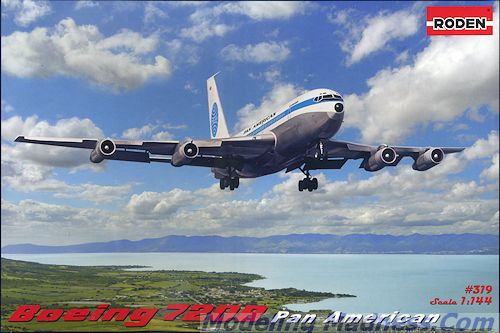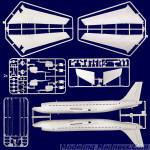
Roden 1/144 Boeing 720B
| KIT #: | 319 |
| PRICE: | $38.00 SRP |
| DECALS: | One option |
| REVIEWER: | Scott Van Aken |
| NOTES: |

| HISTORY |
1954 saw the first flight of the Boeing Model 80 an intercontinental passenger plane which radically changed the concept of air transportation. The Boeing 707, which was derived from the Model 80, was a truly revolutionary airplane, and it is not surprising that its great success encouraged its manufacturer to develop a version for short-haul & medium-haul transport. The first flight of the new machine, now known as the Boeing 720, took place in November 1959. The Boeing 720 differed very little visually from its predecessor, and only a careful examination could tell the difference between these machines. The fuselage of Boeing 720 was shorter by 2.45m, and the wing had a slightly bigger sweep and other mechanical changes. The lift to weight ratio was more favourable, which allowed simplification of diverse elements of the design and the saving of weight and fuel consumption. The Boeing 720 could carry 116 people - 38 in the first class salon and 78 in second class. For passenger comfort three kitchens and three toilets were provided. The plane had JT3C-7 engines of 5670 kgf thrust each.
On July 5, 1960 the first machine N7201U was delivered to United
Airlines. The further history of this machine is interesting - it was later
purchased by private owners who refurbished the airplane as a VIP transport. The
most famous occupants of this plane were the rock groups Led Zeppelin and Deep
Purple, and the pop stars Elton John and Sonny & Cher. In total 65 machines were
produced of this variant, which was soon modified as the Boeing 720B with more
powerful JT3D engines. 89 of the 720B were produced.
The Boeing 720B differed visually from its predecessor in the new shape of its
engine nacelles, and also in the different arrangement of doors and emergency
exits on the sides of the fuselage. One of its earliest and best-known operators
was one of the oldest U.S. airlines, Pan American. The take-off weight of this
advanced version was increased a little, however all other characteristics
remained almost without change.
The Boeing 707's successor did not achieve the huge success which it had enjoyed. The airlines did buy the 720, but without special interest. A large number of machines was soon sold on by American owned airlines to other countries and to other continents. Some machines were in use until the early 1990's.
| THE KIT |
 To
my limited knowledge, this is the only 720 produced in this scale in injected
plastic. It is one that Roden has so far done in a handful of boxings. It is a good choice of subjects as many of us remember the
days when flying was enjoyable instead of the major hassle it is nowadays.
To
my limited knowledge, this is the only 720 produced in this scale in injected
plastic. It is one that Roden has so far done in a handful of boxings. It is a good choice of subjects as many of us remember the
days when flying was enjoyable instead of the major hassle it is nowadays.
The kit is superbly molded with nicely engraved panel lines. The kit itself is devoid of flash and Roden has chosen to mold the windows in the fuselage such as is done by Airfix and Revell, for example. There are those of us would prefer Minicraft and Hasegawa's approach with decals, but there are others who like this method. I prefer the decals as it makes it easier to paint. Those who like windows will simply say to paint the fuselage halves first before installing the windows and then repainting the joins.
I should mention that there really are two engine sprues but only one is shown. Assembly will be pretty straight-forward as airliners are basically hassle free for the most part. There is no cockpit as such which really isn't that big a deal on planes like this and provides lots of room for nose weight, which you will need. I do like that the cockpit windows are molded in with the fuselage section around them. For one thing, the seams line up and it makes it a bit easier to mask the clear parts of the piece. Other clear bits are all the cabin windows. Many modelers of airliners like putting their planes in flight and on stands. Well you can do the in flight part, but stands seem to be a thing of the past in many cases and one is not included.
 Instructions
are well done and there are markings included for one aircraft, that being a
Pan Am Airlines plane from the 1960s. The decals are very nicely done and thanks
to a lack of compound curves should provide no issues. I did notice that Roden
missed the aluminum surround to each of the cabin windows on the fuselage
stripe. In any case, I'll bet the aftermarket folks will soon be helping out if
not already as there are a ton of very nice schemes carried by the 720.
Instructions
are well done and there are markings included for one aircraft, that being a
Pan Am Airlines plane from the 1960s. The decals are very nicely done and thanks
to a lack of compound curves should provide no issues. I did notice that Roden
missed the aluminum surround to each of the cabin windows on the fuselage
stripe. In any case, I'll bet the aftermarket folks will soon be helping out if
not already as there are a ton of very nice schemes carried by the 720.
| CONCLUSIONS |
We can thank Roden for producing this version of the 707 as it has been needed for quite some time. Even in 1/144 scale, it makes for a pretty good sized model and will look great in with your other jetliners.
| REFERENCES |
Roden web site
October 2014
Thanks to me for picking this one up.
If you would like your product reviewed fairly and fairly quickly, please contact the editor or see other details in the Note to Contributors.